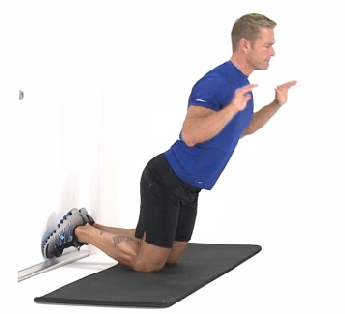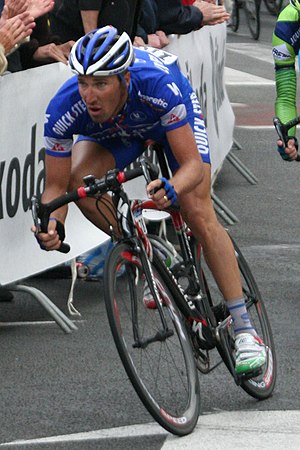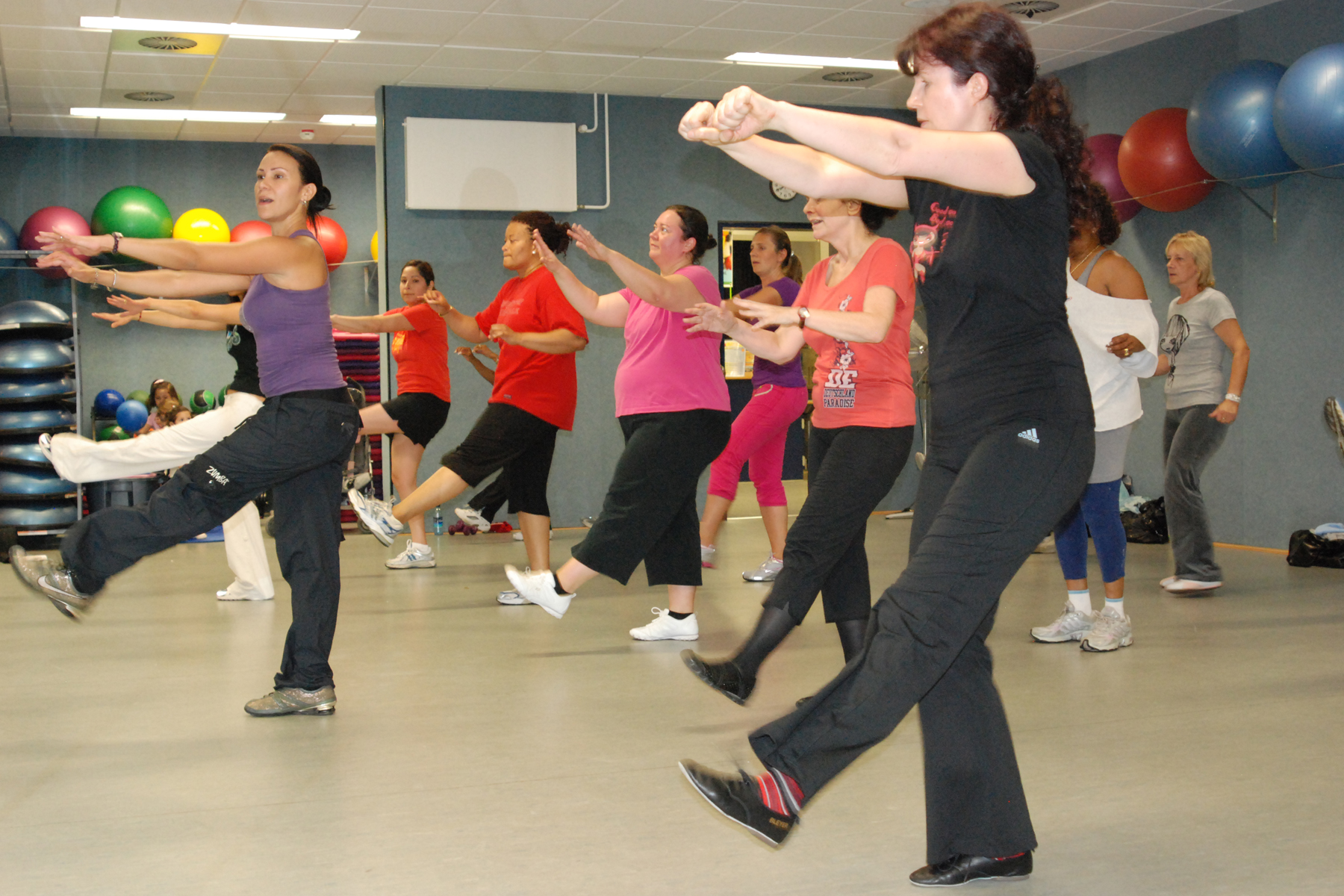Fitness Exercises Biography
Source:- Google.com.pk
Physical exercise is any bodily activity that enhances or maintains physical fitness and overall health and wellness. It is performed for various reasons including strengthening muscles and the cardiovascular system, honing athletic skills, weight loss or maintenance, as well as for the purpose of enjoyment. Frequent and regular physical exercise boosts the immune system, and helps prevent the "diseases of affluence" such as heart disease, cardiovascular disease, Type 2 diabetes and obesity. It also improves mental health, helps prevent depression, helps to promote or maintain positive self-esteem, and can even augment an individual's sex appeal or body image, which is also found to be linked with higher levels of self-esteem. Childhood obesity is a growing global concern and physical exercise may help decrease some of the effects of childhood and adult obesity. Health care providers often call exercise the "miracle" or "wonder" drug—alluding to the wide variety of proven benefits that it provides.Physical exercises are generally grouped into three types, depending on the overall effect they have on the human body:
Aerobic exercise is any physical activity that uses large muscle groups and causes your body to use more oxygen than it would while resting. The goal of aerobic exercise is to increase cardiovascular endurance. Examples of aerobic exercise include cycling, swimming, brisk walking, skipping rope, rowing, hiking, playing tennis, continuous training, and long slow distance training.
Anaerobic exercise is also called strength or Resistance training and can firm, strengthen, and tone your muscles, as well as improve bone strength, Balance, and Coordination. Examples of strength moves are pushups, lunges, and bicep curls using dumbbells. Anaerobic exercise also include weight training, functional training, eccentric training, Interval training, sprinting and high-intensity interval training increase short-term muscle strength.
Flexibility exercises stretch and lengthen your muscles. Activities such as stretching help to improve joint joint flexibility and keep muscles limber. The goal is to improve the range of motion which can reduce the chance of injury.
Physical exercise can also include training that focuses on accuracy, agility, power, and speed.
Sometimes the terms 'dynamic' and 'static' are used.[citation needed] 'Dynamic' exercises such as steady running, tend to produce a lowering of the diastolic blood pressure during exercise, due to the improved blood flow. Conversely, static exercise (such as weight-lifting) can cause the systolic pressure to rise significantly (during the exercise).
Health effects
A common elliptical training machine
US Marines exercising on the USS Bataan
Physical exercise is important for maintaining physical fitness and can contribute positively to maintaining a healthy weight, building and maintaining healthy bone density, muscle strength, and joint mobility, promoting physiological well-being, reducing surgical risks, and strengthening the immune system. Developing research has demonstrated that many of the benefits of exercise are mediated through the role of skeletal muscle as an endocrine organ. That is, contracting muscles release multiple substances known as myokines which promote the growth of new tissue, tissue repair, and multiple anti-inflammatory functions, which in turn reduce the risk of developing various inflammatory diseases.
Exercise reduces levels of cortisol, which causes many health problems, both physical and mental.
Endurance exercise before meals lowers blood glucose more than the same exercise after meals.According to the World Health Organization, lack of physical activity contributes to approximately 17% of heart disease and diabetes, 12% of falls in the elderly, and 10% of breast cancer and colon cancer.
There is evidence that vigorous exercise (90–95% of VO2 Max) induces a greater degree of physiological cardiac hypertrophy than moderate exercise (40 to 70% of VO2 Max), but it is unknown whether this has any effects on overall morbidity and/or mortality.
Exercise in space: Astronaut Daniel Tani, Expedition 16 flight engineer, works out at the Unity node of the International Space Station using the short bar of the Interim Resistive Exercise Device (IRED) to perform pull-ups to increase his upper body strength while in a microgravity environment
Some studies have shown that vigorous exercise executed by healthy individuals can increase opioid peptides (a.k.a. endorphins, naturally occurring opioids that in conjunction with other neurotransmitters are responsible for exercise-induced euphoria and have been shown to be addictive), increase testosterone and growth hormone, effects that are not as fully realized with moderate exercise. More recent research[indicates that anandamide may play a greater role than endorphins in "runner's high". However, training at high intensity for long periods of time, or without proper warmup beforehand and cooldown afterwards, can lead to an increased risk of injury and overtraining.[citation needed]
Both aerobic and anaerobic exercise work to increase the mechanical efficiency of the heart by increasing cardiac volume (aerobic exercise), or myocardial thickness (strength training). Ventricular hypertrophy, the thickening of the ventricular walls, is generally beneficial and healthy if it occurs in response to exercise
Not everyone benefits equally from exercise. There is tremendous variation in individual response to training; where most people will see a moderate increase in endurance from aerobic exercise, some individuals will as much as double their oxygen uptake, while others can never augment endurance. However, muscle hypertrophy from resistance training is primarily determined by diet and testosterone. This genetic variation in improvement from training is one of the key physiological differences between elite athletes and the larger population. Studies have shown that exercising in middle age leads to better physical ability later in life.Physical fitness is a general state of health and well-being or specifically the ability to perform aspects of sports or occupations. Physical fitness is generally achieved through correct nutrition, exercise, hygiene and rest. It is a set of attributes or characteristics that people have or achieve that relates to the ability to perform physical activity.
Before the industrial revolution, fitness was the capacity to carry out the day’s activities without undue fatigue. However with automation and changes in lifestyles physical fitness is now considered a measure of the body’s ability to function efficiently and effectively in work and leisure activities, to be healthy, to resist hypokinetic diseases, and to meet emergency situations.
Fitness[edit]
Balance Training.
A U.S. Marine performing a fitness routine.
The President's Council on Physical Fitness and Sports — a study group sponsored by the government of the United States—declines to offer a simple definition of physical fitness. Instead, it developed the following chart:A comprehensive fitness program tailored to an individual typically focuses on one or more specific skills, and on age- or health-related needs such as bone health. Many sources[citation needed] also cite mental, social and emotional health as an important part of overall fitness. This is often presented in textbooks as a triangle made up of three points, which represent physical, emotional, and mental fitness. Physical fitness can also prevent or treat many chronic health conditions brought on by unhealthy lifestyle or aging. Working out can also help people sleep better. To stay healthy it is important to engage in physical activity.
The U.S. Centers for Disease Control and Prevention encourages the adult public, ages 18 to 64, to engage each week in at least one and a quarter hours of vigorous-intensity aerobic activity or two and a half hours of moderate-intensity aerobic activity; that time can be met in any increments.
Diet is an important component to overall health that works best in combination with exercise.[citation needed] A balanced diet and exercising regularly are important for maintaining good health. Obesity is defined as body mass index, a measure of weight in relationship to height (Blair, 1993). With obesity on the rise, the U.S. has implemented more exercise and diet plans. There are millions of programs, websites, television shows, magazines, and movies regarding health and fitness. Recently, the trends of diets and lifestyle habits have become more and more encouraged. Understanding the importance of the health benefits resulted from diet and exercise will help decrease the amount of obesity in this country. Physical activity and exercise is defined in terms of type, intensity, duration and frequency (Blair, 1993).
Developing research has demonstrated that many of the benefits of exercise are mediated through the role of skeletal muscle as an endocrine organ. That is, contracting muscles release multiple substances known as myokines which promote the growth of new tissue, tissue repair, and various anti-inflammatory functions, which in turn reduce the risk of developing various inflammatory diseases.
Fitness Exercises Fitness Motivation Quotes Models Inspiration Motivational Quotes Women Logo Girl First Selfies
Fitness Exercises Fitness Motivation Quotes Models Inspiration Motivational Quotes Women Logo Girl First Selfies
Fitness Exercises Fitness Motivation Quotes Models Inspiration Motivational Quotes Women Logo Girl First Selfies
Fitness Exercises Fitness Motivation Quotes Models Inspiration Motivational Quotes Women Logo Girl First Selfies
Fitness Exercises Fitness Motivation Quotes Models Inspiration Motivational Quotes Women Logo Girl First Selfies
Fitness Exercises Fitness Motivation Quotes Models Inspiration Motivational Quotes Women Logo Girl First Selfies
Fitness Exercises Fitness Motivation Quotes Models Inspiration Motivational Quotes Women Logo Girl First Selfies
Fitness Exercises Fitness Motivation Quotes Models Inspiration Motivational Quotes Women Logo Girl First Selfies
Fitness Exercises Fitness Motivation Quotes Models Inspiration Motivational Quotes Women Logo Girl First Selfies
Fitness Exercises Fitness Motivation Quotes Models Inspiration Motivational Quotes Women Logo Girl First Selfies
Fitness Exercises Fitness Motivation Quotes Models Inspiration Motivational Quotes Women Logo Girl First Selfies










No comments:
Post a Comment